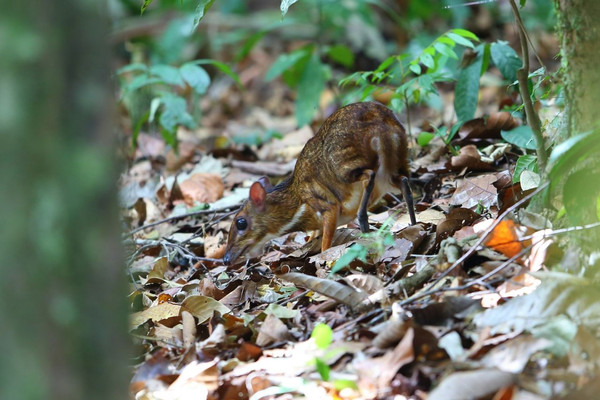Western Tarsier
Borneo’s Wonderful Wildlife!

Operations Manager
1st December 2018
In October 2018, Operations Manager, Tom Mabbett, led our ‘Borneo's Mammals – Deramakot Forest Reserve’ tour to Sabah, and then extended his stay to explore Tabin Wildlife Reserve and to visit Borneo Rainforest Lodge in the Danum Valley Conservation Area. Here he describes the highlights of his trip and answers some commonly-asked questions about the island and its wonderful wildlife!
What were the highlights of your recent tour?
The holiday was packed with outstanding wildlife encounters! We saw an amazing 18 different wild Orangutans, with some truly exceptional views. The wonderfully bizarre and elusive Binturong was a particular treat, while both Greater and Lesser Mouse-deer and the striking Moonrat were amongst other highlights. We enjoyed many Colugo and Slow Loris sightings, often at close quarters, and the beautiful Sunda Leopard Cat was a favourite for many. Birding highlights included Bornean Falconet, Hooded Pitta and Red-bearded Bee-eater and, with over 40 mammal and 160 bird species encountered in total, every day held a new and exciting discovery.
What’s the best time of year to travel to Borneo?

All of our Borneo holidays visit the Malaysian state of Sabah which can be explored year-round, although April to September is generally considered to be the best time to visit. On any tour you can expect a lot of sunshine, together with typically short, sharp tropical showers which do not usually impinge on the day’s wildlife activities. The ‘official’ wet season runs from October to February, but since Sabah is largely covered by tropical rainforest, with around 2,000 millimetres of annual rainfall, there is not really a ‘dry season’ to speak of. Daytime temperatures sit at between 25 to 32°C year-round and the humidity is always high. Always carry water! The higher areas around Mount Kinabalu are much cooler and nights here can feel decidedly chilly.
What are my chances of seeing a Sunda Clouded Leopard?
Naturetrek groups have been fortunate enough to see this stunningly beautiful and rarely-seen feline on a number of occasions over the past 20 or so years. However, it is only recently that our groups have been visiting Deramakot, and we saw our first Sunda Clouded Leopard here in 2017. In recent years our team of dedicated local guides and spotters have become more familiar with the Sunda Clouded Leopard’s movements and territories, and sightings are on the increase as a result. On average a sighting is achieved for every seven nights spent in the Deramakot Forest Reserve and around 40% of our groups have enjoyed an encounter with this secretive creature (almost always after dark). Of course, while searching for Sunda Clouded Leopard our groups have encountered a whole host of other interesting wildlife including Marbled Cat, Greater and Lesser Mouse-deer, Moonrat and the rare Otter Civet to name just a few.


If I want to see Orangutans in the wild, where should I go?
The wonderful and charismatic Orangutan is quite rightly at the top of the wish-list of most who travel to Borneo in search of wildlife. This great ape has suffered a dramatic decline in recent years due to the well-documented destruction of its rainforest habitat and the expansion of palm oil plantations. However, a population of about 800 Orangutans still thrives in the protected forests bordering the Kinabatangan River, an area that is included in all of our Naturetrek Borneo itineraries. The best way to look for them is on a relaxing boat-trip along the river, scouring the riverside forest and, in particular, looking for the fruiting trees that are favoured by the apes. The special tract of primary forest in the Danum Valley, which we visit on our ‘Borneo’s Orangutans’ tour and holiday extensions, is another reliable site and there are regular sightings at Deramakot too.
How easy is it to find the wildlife within the dense rainforest?
Finding wildlife in tropical forests is always a challenge due to the dense vegetation, low light levels and the crepuscular nature of many of the animals that live there. That’s all part of the fun, however, and a key part of our success in Borneo comes from working with only the very best local wildlife guides and spotters; their sharp eyesight and superb field skills have to be seen to be believed! Treading lightly, driving the more open tracks, accessing the canopy and working closely with our local guides all help to ensure that we maximise our chances of encountering the most alluring, and rarely seen, animals and birds of this threatened habitat.
Do you have a favourite Bornean creature?
Borneo is home to many weird and wonderful animals, but if I have to pick one favourite then I would choose the Colugo. These amazing creatures – which look like a cross between a flying-squirrel and a lemur – are the most accomplished gliders of all mammals and use the flaps of skin between their legs to allow them to glide from tree to tree.





 Loading search...
Loading search...